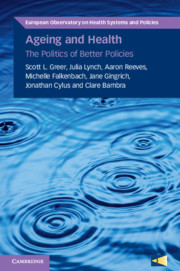Book contents
- Ageing and Health
- European Observatory on Health Systems and Policies
- Series page
- Ageing and Health
- Copyright page
- Additional material
- Additional material
- Contents
- Figures
- Tables
- Boxes
- Acknowledgements
- 1 Introduction
- 2 Older People in Europe
- 3 Ageing Equally: Politics, Health and Solidarity
- 4 The Coalitional Politics of Win-Wins
- 5 Unequal Ageing: the Politics of Ageing As the Politics of Health Inequalities
- 6 The Implications of Win-Win and Win-Lose Policies for the ‘Ageing Crisis’
- 7 Conclusion
- Bibliography
- Index
- References
Bibliography
Published online by Cambridge University Press: 22 July 2021
- Ageing and Health
- European Observatory on Health Systems and Policies
- Series page
- Ageing and Health
- Copyright page
- Additional material
- Additional material
- Contents
- Figures
- Tables
- Boxes
- Acknowledgements
- 1 Introduction
- 2 Older People in Europe
- 3 Ageing Equally: Politics, Health and Solidarity
- 4 The Coalitional Politics of Win-Wins
- 5 Unequal Ageing: the Politics of Ageing As the Politics of Health Inequalities
- 6 The Implications of Win-Win and Win-Lose Policies for the ‘Ageing Crisis’
- 7 Conclusion
- Bibliography
- Index
- References
Summary
- Type
- Chapter
- Information
- Ageing and HealthThe Politics of Better Policies, pp. 134 - 161Publisher: Cambridge University PressPrint publication year: 2021
- Creative Commons
- This content is Open Access and distributed under the terms of the Creative Commons Attribution licence CC-BY-NC-ND 3.0 https://creativecommons.org/cclicenses/

